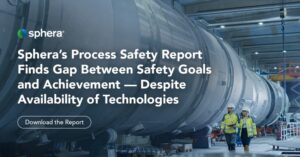Process safety management (PSM) is a critical component of operational risk management (ORM). It enables organizations to ensure the safety of their people, their assets and the communities in which they operate. We believe that effective PSM is also essential for operational ESG and for optimizing ESG performance.
The relationship between PSM and ESG is evident in our 8th annual Process Safety Report, which is based on the results of our annual Process Safety Survey. With nearly 240 respondents this year—46% of whom have over 15 years of PSM and/or ORM experience—the survey results provide useful insights into how organizations approach PSM.
One thing is clear: Respondents value technology solutions that help them manage process safety effectively. Sixty-five percent of respondents believe that digital solutions now enable sound PSM, while 35% believe that technology will support PSM in the future. Eighty percent agree that technology reduces an organization’s vulnerability to hazard events, and 83% believe that risk awareness and safety are improved when the workforce and management have access to digitized, real-time process safety risk indicators. The use cases for technology in process safety and operational risk management are many, and we expect to see increasing reliance on digital solutions in the coming years.
We’re already seeing companies shift toward more proactive PSM through the use of technology. This year, the percentage of survey respondents who believe that their organization optimizes its use of technology or leads in terms of technology use grew to 48%, up from 43% last year. Those who see their organization on the lower end of the technology use spectrum are decreasing. As PSM and ORM practitioners have come to understand, technology enables companies to get in front of the elements that can compromise the safety of their workers and assets and interfere with operations.
Business continuity—like safety—is always front of mind, and our report looks at the internal and external factors that impact process safety and operations. Last year we noted the effects of “The Great Resignation”—the wave of workplace departures that accelerated during the COVID-19 pandemic. For many companies, it resulted in the loss of valuable process safety knowledge and experience. Sixty-two percent of our 2022 survey participants said this loss of experienced personnel caused risk to increase, while 52% report this as a factor this year. It’s possible that more organizations are relying on digital tools to capture and share the expertise of individuals—as well as lessons learned—to minimize the impact of departures. We hope this trend continues.
It’s in employees’ best interests to support process safety, but things don’t always work that way. Sometimes people get in the way of effective PSM. When considering the factors that can negatively affect process safety, 63% of survey participants cite human factors, and 52% point to organizational culture. Nearly half (46%) of respondents say that conflicts between policies/procedures and frontline working practices cause risk to increase.
As our report points out, there are several things that company leaders can do to minimize human error or noncompliance with policies and procedures. At the top of the list are digital solutions, which should be deployed to reduce the risk of human error. Additionally, change management must accompany the introduction of new technologies, and employees must see buy-in and alignment throughout the organization. Furthermore, employees should not be operating within silos; rather, they need a connected view of the organization and an appreciation for the role they can play in promoting safety.
While technology and a reduction in human error help keep people, plants and assets safe, the process safety puzzle can’t be completed without safety-critical maintenance. Yet our survey indicates that organizations struggle to complete 100% of scheduled safety-critical maintenance in a typical month. Remarkably, respondents say that roughly one-third of safety-critical maintenance is not achieved. This may be due to the reluctance to take assets offline for maintenance when others are prioritizing production goals. Or it could be caused by differing opinions as to what’s “critical.” Either way, this trend merits closer examination.
When PSM is practiced well, it ensures the safety and security of people and assets, allowing businesses to focus on their core competencies. Most survey respondents (86%) agree that PSM is critical for ESG, with the majority seeing the connection to the governance and environmental pillars of their companies’ ESG programs.
There are more insights to gain about the state of PSM and ORM, the role of technology and the link between PSM and ESG, and you’ll find them in our 8th annual Process Safety Report. We can all play a role in creating a safer, more sustainable and productive world, and sound process safety and operational risk management will go a long way in helping us achieve this.
–Paul
Learn more about Paul Marushka.






